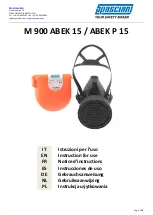
32
Thermo Scientific Orion
V
ersa
s
tar
pH with LogR Temperature Module
Initial Electrode Check
To get the most out of the Orion
V
ersa
s
tar
Meter and pH with LogR Module system’s diagnostics, you may want
to establish a regular schedule of resistance testing. Perform an initial check of your electrode resistance and record
the temperature and resistance value in the table below, or perform a LogR calibration and output the calibration
information from the meter to a computer or printer. (Refer to the chapter titled LogR and Automatic Temperature
Compensation (ATC) Calibration and the chapter titled Data Archiving and Retrieval for more information).
1. Rinse the electrode with deionized water and blot dry with a lint-free tissue.
2. Insert the electrode into the solution and gently stir – if a stirrer probe is enabled, press the stir key to
start and stop stirring.
3. Record the temperature and resistance value for reference.
Note:
Electrode bulb thickness and diameter vary from electrode to electrode resulting in normal variation in
resistance. In most cases the initial value is not a definitive test of electrode condition except in extreme cases,
for example, see the
initial low readings
information below. When changing electrodes, do not be alarmed if the
resistance varies dramatically from your previous electrode.
Initial Low Readings
– If the resistance is below 1 MΩ in a solution at room temperature (22 º to 27 ºC),
this indicates a damaged electrode. In this case the electrode will most likely need to be replaced.
Periodic Electrode Testing
Periodically check your electrode resistance following the steps above and record values in the table below. While
diagnostic testing at (or near) 25 ºC is ideal due to the resistance stability at this temperature, this may not be possible.
Nonetheless, it is important to maintain as many sampling variables constant to get the most out of your periodic
testing. The resistance reading is fully dependent on temperature. When testing, using the same solution type at a
known, stable temperature at or around the same temperature value each time would be the most beneficial method.
Small Variances in Resistance
– Resistance will typically increase as the bulb ages. This is no cause for
concern. Over time this can lead to slower response rates, slope degradation, and reduced immunity to noise.
By keeping track of the change in resistance (delta, as listed in the log example below), this information may be used
to determine when to replace your electrode, before failure occurs, eliminating down time.
Large Decreases in Resistance
– When the glass pH membrane resistance is more than ten times lower
than the expected resistance value (at a given temperature), it is often an indication of membrane crack in the bulb or
shorting, leading to a total failure in function. If you see this type of change in the resistance reading, no further testing
or care will resolve the problem. A new electrode will be needed at this point.
Increases in Resistance
– As the electrode ages, the resistance of the electrode’s glass bulb increases.
Eventually, the aging of the electrode, and visible increase in resistance, manifests in a slower response rate, low slope,
and reduced immunity to noise. At some point the resistance becomes “super high”. The Orion
V
ersa
s
tar
Meter and
pH with LogR Module system’s diagnostics help you pinpoint the causes of your reduced performance and quickly show
you the effectiveness of your cleaning and care processes.
Содержание Orion Versa Star VSTAR-PH
Страница 1: ...Thermo Scientific Orion Versa Star pH with LogR Temperature Module Reference Guide...
Страница 6: ...This page intentionally left blank...
Страница 12: ...8 Thermo Scientific Orion Versa Star pH with LogR Temperature Module This page intentionally left blank...
Страница 18: ...14 Thermo Scientific Orion Versa Star pH with LogR Temperature Module This page intentionally left blank...
Страница 20: ...16 Thermo Scientific Orion Versa Star pH with LogR Temperature Module This page intentionally left blank...
Страница 38: ...34 Thermo Scientific Orion Versa Star pH with LogR Temperature Module Notes...
Страница 39: ...This page intentionally left blank...





































